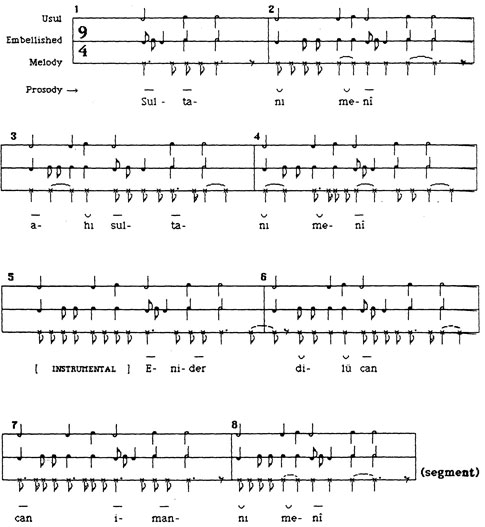|
Mevlevi Âyin Rhythmic Layers Fourth Selâm The first eight rhythmic layers below are familiar to those knowledgeable about Turkish art music. Each layer is described in general terms useful for the later discussion of taksim. 1. STEADY BEAT. The fundamental rhythmic layer of every composed piece is an implied steady beat. 2. USUL DURATION. Every composed piece is based on an usul (rhythmic cycle) which selects a duration of a specified number of beats. The composer for this musical selection chose Usul Evfer (9 beats) 3. USUL PATTERN. Atop the steady beat and within the given duration, the usul lays down a pattern of long vs. short and low vs. high pitch drum beats. 4. USUL EMBELLISHMENT. In the Mevlevi context, the drums always play velveleli (embellished) versions of all usul-s. 5. MELODIC RHYTHM. A good
composer creates su 6. MELODIC PHRASE DURATION. In this Selâm (movement), the duration of each melodic phrase occupies one-and-one-half cycles of the usul. The composer fills in the remaining half cycle with vocables and, before the significant third line, a brief instrumental interlude for the singer. 7. POETIC METER. The arûz (poetic meter) configures each line of text in a pattern of long and short syllables, analogous to the usul configuration but less rigidly applied. 8. RHYME SCHEME. The rhyme scheme of the poem, in this verse AABA, is reinforced by the melody reaching its highest point in the non-rhyming third line (B). The analytical score below compares rhythmic layers 2–8.
Going beyond these well-known
definitions, we can find at least two more r 9. TEXT EMPHASIS. At the utterance of the name "Şemsi Tabrizi" in the lyrics, the musicians in the mutrip (ensemble) and the dervishes (semazenler) incline their heads. If we accept the text as part of the music, one could argue that this obeisance highlights the significance of this name and is thus an element of the text. The obeisance is then a one-time marker along the musical timeline. See also Vicente 2007. 10. MODULATION DURATION. At the macro level of the complete Beyati âyini, makam modulations mark off time segments (durations) throughout the four Selâm-s. At the micro-level this is analogous to marking off time segments for an usul but the modulations have irregular durations compared to the regular duration of an usul. This framework for finding and defining rhythmic layers in one composition should apply as well for any composition of Turkish art music, tasavvufi (Sufi) or secular. This framework also prepares us for finding and defining rhythmic layers in a solo instrumental improvisation constructed with no beat, no usul, and no text. |
 btle
interactions between the rhythm of the melodic line and the rhythm of the
usul.
btle
interactions between the rhythm of the melodic line and the rhythm of the
usul.
 hythmic
layers less commonly recognizable.
hythmic
layers less commonly recognizable.